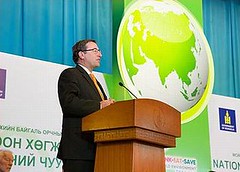每年6月5日舉世慶祝世界環境日,今年的主題是減少食物浪費。
為響應世界環境日,4日美國環保署代理署長Bob Perciasepe和美國農業部長Tom Vilsack共同宣布啟動美國食物節約計劃,要求農民、加工廠、製造廠、零售商、社區和政府機關一同減少食物浪費。
Perciasepe指出,「廚餘是我國掩埋場中最大宗的廢棄物-美國人有高達40%的食物被扔進垃圾桶。解決這個問題不但有助於對抗飢餓和省錢,還能對抗氣候變遷。垃圾場中的廚餘分解會產生威力強大的溫室氣體,若能減少廚餘,我們能同時減少溫室氣體排放量。」
Vilsack也表示,「美國有全世界最充足的食物供給,但也有太多食物被浪費掉。這些食物不但能讓給真正需要的人,我們也有機會減少掩埋場的廚餘量。透過和環保署和全國企業攜手合作,我們能將食物浪費的後果和嚴重性傳遞給大眾,讓全國各地一起來解決這個問題。」
在美國人丟進掩埋場和焚化爐的垃圾當中,食物佔最大比例──3500萬噸,甚至比紙類跟塑膠都要多。
廚餘被丟進掩埋場後會分解,產生溫室效應比二氧化碳更強的溫室氣體甲烷,加劇氣候變遷。
減少廚餘有助於保存能量,並減少生產和運輸食物對環境造成的影響。
全世界有數十萬人已參與或準備參加世界環境日活動。官方活動以聯合國環境規劃署和聯合國糧農組織舉辦的「Think.Eat.Save.」減少食物足跡活動為主軸,以減少食物浪費為宗旨。
每年被生產出的食物中,估計有三分之一被消費者、零售業者、農民和運輸業者丟棄,產生13億公噸、總價值約1兆美元的廚餘,足以餵飽8億7千萬每天挨餓多次的人們。
 今年世界環境日由蒙古政府和民間所主辦。蒙古全世界成長最快速的國家之一,不過整體來說浪費食物的情況並不嚴重,部分蒙古人民的傳統游牧生活形態發展出長久保存食物的方法,古老的智慧為食物浪費這個現代議題帶來不少啓發。
今年世界環境日由蒙古政府和民間所主辦。蒙古全世界成長最快速的國家之一,不過整體來說浪費食物的情況並不嚴重,部分蒙古人民的傳統游牧生活形態發展出長久保存食物的方法,古老的智慧為食物浪費這個現代議題帶來不少啓發。
6月1日在蒙古首都烏蘭巴托的中央廣場,以環境為訴求的快閃活動為一連串世界環境日和國際兒童日慶祝活動揭開序幕。6月2日,數千名跑者參加聯合國環境署健康空氣馬拉松,由世界馬拉松紀錄保持人領跑,穿越烏蘭巴托市中心的封街路段。
6月3日,蒙古召開全國綠色發展論壇。蒙古礦藏豐富,但目前已禁止開發新礦場,轉而發展更永續的可再生能源和生態旅遊產業。
6月4日,蒙古的第一座風力發電廠開始運轉。這座風力發電廠位於蒙古中央省薩吉特山,是蒙古力求轉型成低碳國家的具體行動之一。同日,蒙古召開「再生能源未來和綠色發展會議」,探討蒙古的再生能源和綠色發展,可望重新定義理性而永續的發展模式。
Each year, June 5 is celebrated around the world as World Environment Day, and this year the focus of attention is on reducing food waste.
In keeping with this effort, today U.S. EPA Acting Administrator Bob Perciasepe joined U.S. Department of Agriculture Secretary Tom Vilsack to announce the launch of U.S. Food Waste Challenge. The challenge asks farmers, processors, manufacturers, retailers, communities and government agencies to help reduce wasted food.
"Food waste is the single largest type of waste entering our landfills – Americans throw away up to 40 percent of their food," said Perciasepe. "Addressing this issue helps to combat hunger and save money, while also combating climate change. Food waste in landfills decomposes to create potent greenhouse gases and by reducing this waste we can in turn reduce greenhouse gas emissions."
"The United States enjoys the most productive and abundant food supply on earth, but too much of this food goes to waste," said Secretary Vilsack. "Not only could this food be going to folks who need it – we also have an opportunity to reduce the amount of food that ends up in America's landfills."
"By joining together with EPA and businesses from around the country, we have an opportunity to better educate folks about the problem of food waste and begin to address this problem across the nation," Vilsack said.
Americans send more food to landfills and incinerators than any other single municipal solid waste – 35 million tons – even more than paper and plastic.
When wasted food is sent to landfills, it decomposes and becomes a source of methane, a potent greenhouse gas that contributes to climate change.
Reducing wasted food helps conserve energy and reduces environmental impacts from thee production and transportation of food.
Around the world hundreds of thousands of people are already participating in World Environment Day events or gearing up to do so. Official events focus on the new UN Environment Programme and UN Food and Agricultural Organization campaign Think.Eat.Save. Reduce Your Foodprint, which is aimed at slashing food waste.
Each year, an estimated one third of all food produced ends up spoiling in the bins of consumers, retailers, farmers and transporters.
This 1.3 billion metric tonnes, worth around US$1 trillion, is enough to feed the 870 million people who go hungry each day several times over.
This year the main World Environment Day event is hosted by the government and people of Mongolia, one of the world's fastest-growing countries. While Mongolia as a whole does not waste much food, the traditional nomadic lifestyle of some of its people, who developed ways to preserve food for long periods, offers some ancient answers to the modern challenge of food waste.
In Mongolia, festivities began on Saturday with International Children's Day with environmental flashmobs in the Central Square of the capital city, Ulaanbaatar.
On Sunday, thousands of runners took part in a marathon flagged off by current marathon world record holder Patrick Makau, the UNEP Patron for Clean Air. The runners passed through the streets of Ulaanbaatar on a day where the city center was designated car free.
On Monday, Mongolia hosted a Green Development National Forum. The mineral-rich country has placed a moratorium on new mining concessions while looking to a more sustainable future based on renewable energy and ecotourism.
Today, Mongolia flipped the switch on its first wind farm on Salhit Mountain in Tuv Province as part of the country's transition to a low-carbon future.
Also today, the Mongolia Renewable Energy Futures and Green Development conference is exploring the relationship between renewable energy and green development in Mongolia, where there is a potential to redefine rational and sustainable growth.
※ 全文及圖片詳見:ENS



